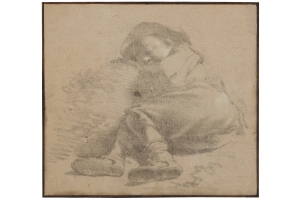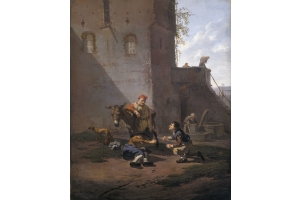

Born as the youngest son of the fat renderer Charles de Jardin/Gardyn (c. 1599 - before 1650) and Catalyn Borchout (1588 - before 1650) Karel Dujardin developed into a multitalented painter most famous for his sun-drenched italianate landscapes who also painted history pieces and portraits mainly of patricians. His most famous being the portrait of Admiral Michiel Adriaensz. de Ruyter who he painted in 1669.[1] Besides all of this, Dujardin also was a gifted draughtsman and etcher.
The initial contact between the humble origins of Dujardin and the Amsterdam Elite probably established by Joan Le Gouche, a far relative of Karel's mother.[2] Shortly before 1649 on his way to Italy most probably to complete his artistic training Dujardin traveled via Lyon where he was unable to pay his bills at the Inn of Suzanne van Royen who forced him to marry her in cancellation of his debt. Karel lived shortly in The Hague between 1656 and 1659 where he was a founding member of the confraterny Pictura, after which he returns to Amsterdam again. Here he painted amongst others the splendid portraits of Jacob de Graeff (1642-1690) and Joan Reynst, Karel's friend, neighbour and landlord. In 1675 Karel left for Italy were he joined the Bentveughels and was given the nickname Bokkebaert (Goatsbeard). In 1678 he traveled to Venice where he most likely died from food poisoning. A few days later Suzanne died, unaware of her husband's earlier death.
Karel is thought to have studied with Nicolaes Berchem (1621-1683) because of the similarities between their italianate landscapes. Dujardin's (imaginary) landscapes are characteristic sun-drenched views of Rome and it's vicinity with shepherds, peasants and travellers under clear blue skies and harbours with traders. Karel has also been suggested to have studied with Bamboccio Pieter van Laer (1599-1642) and was influenced by Paulus Potter (1625-1654) and his second cousin Pieter Nason (1612-1688).[2] Dujardin became one of the best paid painters of 17th century Amsterdam.
The present couterproof was taken from the genre drawing of a figure study of a sleeping boy used for the painting in The Royal Collection, Buckingham Palace.[3][4]
Where the original drawing and it's counterproof show a sleeping boy, Dujardin has used the study with quite some pentimento by adjusting the position of the boy's arm creating and interactive scene in which the boy appears to play Morra or Micatio with the kneeling man on the right.
The boy and man are playing Morra, an ancient Roman and Greek hand game known by the name of micatio from micare digitis (to flash with the fingers). This game was popular especially among kids and can be played by two or more where the participants quickly simultaneously reveal one hand while calling out a number. The child who calls the total number of fingers revealed scores a point. The first participant to score three points wins the game.
Dujardin frequently used counterproofs or monotypes to increase his stock of figures ready for integration into a painting as proved by our essay on the this far only known monotype by Dujardin which we sold to the National Gallery of Art, Washinton in 2018.[5]
For another drawing of children playing Morra, please see our drawing by Jan Miel from the collection Johann Edler Goll van Franckenstein.[6]
[1] Oil on canvas, 128 x 104 cm. Nederlands Scheepvaartmuseum, Amsterdam, inv./cat.nr A.0953.
[2] Jennifer Kilian, Karel Dujardin, 1626 - 1678.
Rijksmuseum / Nieuw Amsterdam Uitgevers, 2007. p. 12.
[3] Karel Dujardin, A Muleteer and Two Men Playing a Game of Morra (1650-52).
Oil on canvas, 520 x 418 mm. Signed on the lower left: C. du Jardin.
Royal Collection Trust/Buckingham Palace, London. inv. no. RCIN 406208
[4] Jennifer M. Kilian, The paintings of Karel Dujardin (1626-1678): catalogue raisonné.
John Benjamins, Amsterdam / Philadelphia, 2005. No D8, pag. 131
[5] Karel Dujardin, Two Boys Standing with Backs Turned, 1659.
Oil paint counterproof or monotype with gray wash, 133 x 102 mm.
National Gallery of Art, Washington, inv/ no. 2018.166.1
[6] Jan Miel (Beveren 1599-1664 Turin), Two boys playing morra or micatio.
Black chalk, 157 x 230 mm.
Inscribed J Miel on the lower left in pen and brown ink.